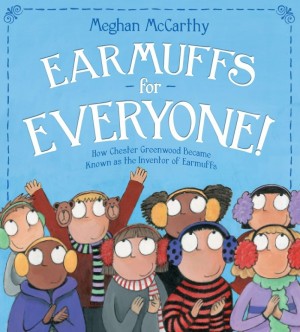
By Kenny Brechner
Everyone now and then one gets the surprise of seeing something profoundly local become the subject of national attention. That happened last year as, going through the forthcoming Simon and Schuster Children’s publishing catalog I encountered the new picture book coming out from one of my favorite non-fiction picture book author/illustrators, Meghan McCarthy.
Meghan’s previous works such as Pop: The Invention of Bubblegum, Daredevil: The Daring Life of Betty Skelton, and Aliens are Coming: The True Account of the 1938 War of the Worlds Radio Broadcast, have all been show stoppers. It was thus with equal parts surprise and pleasure that I noted the December 2014 publication of Earmuffs For Everyone: How Chester Greenwood became Known as The Inventor of the Earmuff.
Earmuff’s For Everyone explores not only the life and inventions of Chester Greenwood, but also the way in which some inventions, whose origins are in fact shared among several inventors, sometimes become popularly attributed to only one of them. This attribution is often due to the workings of creative public relations which come to resonate in the popular imagination. Thomas Edison’s “invention” of electricity is a good example. Today the back story of how the attribution came to reside with Edison rather than with Nikola Tesla, has become of increasing interest. This is true of earmuffs as well, and McCarthy’s charming book recounts how what started out as just a patent on a new variation in earmuffs by the young Greenwood ultimately become Chester’s attribution as the sole inventor of the earmuff itself. That story is filled with Farmington history and lore, and is delightfully recounted by McCarthy.
Meghan will be launching her book at The Chester Greenwood Day in Farmington! She’ll be riding in the Chamber of Commerce float in the parade, followed by a book signing at DDG Booksellers and judging an earmuff coloring contest also at the bookstore. To find out more I caught up with the very busy Meghan.
Kenny: Earmuffs for Everyone is as much about attribution as earmuffs. Did that draw you to the story?

Meghan: The truth is that I had read many articles declaring that the young Chester Greenwood invented earmuffs. I thought that the story of a determined boy-inventor would be a great book idea to pitch to my editor, as she was looking for another invention-type book for me to work on. So I sold the book thinking that Greenwood was the original creator of the earmuff. One of the first things that I did once I got started on the earmuff research was an investigation into Greenwood’s patent.
It reads, “Improvement In Earmufflers.” Where was the original patent? After an extensive search I discovered that many people had obtained patents before Greenwood. After a bit of panicking (or a lot) I contacted my editor and told her that we had to cancel the book because Chester didn’t invent earmuffs!
But, my editor still wanted to do the book. How was I going to make it work? I struggled with this question for a long time. A lot of angry scribbles ended up in the garbage. But after a lot of thought I made a book that is stronger and more interesting than the original. The saying – when you get lemons, make lemonade – is a philosophy to live by!
Kenny: If you could ask Chester Greenwood one question what would it be?
Meghan: When you came up with your earmuff creation as a boy did you know that other earmuffs existed or did you think that your earmuff invention was truly original?
Kenny: I’m a big fan of your illustrations. You have a very distinctive style. One can tell a Meghan McCarthy book from a mile off just from the eyeballs of the characters. What are some of your favorite illustrators or influences?

Meghan: In college I loved artists like Gary Baseman. He was painting crazy cartoons for editorial work. I started buying art and design magazines that showcased artists like him. I’d been painting giant photorealism paintings at the time but after pouring through those art magazines I did a sudden 360 and began bringing in cartoons to class. I was having a lot of fun with them so I decided to focus on the cartoon style for the duration of my career.
Artists like Mark Ryden, Eric White, and Todd Schorr have switched over to doing gallery shows instead of editorial work. A lot of the artists I was looking at moved into what is called “lowbrow” art or “pop surrealism.” I really love that look.
In addition I have a huge collection of art books that contain everything from photography to sculpture. An example of an artist who creates unique art is Tom Friedman. He uses utilitarian items like toothpicks, pencils, and paper and creates amazing sculptures. I also love pop art—artists like Wayne Thiebaud, Roy Lichtenstein, and Claes Oldenburg. I don’t know that all of this art directly influences me but I let it soak in. Perhaps it seeps out eventually.
Kenny: What statement, if a child said it to you, would make you feel that she had totally gotten what you hoped a young reader would from this book?
Meghan: “Wow… it takes a lot of people to make an invention,” or if he or she runs to watch the History Detectives on PBS then that would be cool too.
Kenny: We’re very excited that you are coming up to Farmington for Chester Greenwood Day Meghan!
Meghan: Thanks! Can’t wait!




